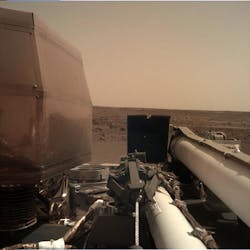Teledyne DALSA (Waterloo, ON, Canada), a Teledyne Technologies [NYSE: TDY] company, provided color CCD image sensors to the Jet Propulsion Laboratory (JPL; Pasadena, CA) for both the Instrument Deployment Camera (IDC) and the Instrument Context Camera on NASA's InSight Mars mission; since the stationary probe's landing on Mars on Nov. 26, 2018, the IDC has already produced its first photo of InSight's surroundings.
The IDC on the lander's arm will provide 3D color views of the landing site, instrument placement, and activities to inform engineers and scientists of the best spots for the seismometer and heat flow probe to gather measurements from the interior of Mars.
Teledyne image sensors are not new to Mars. As recently as 2012, and in an earlier partnership with JPL, the company provided twelve black and white CCD image sensors to power the Mars Curiosity Rover. The Teledyne Imaging Space & Defense group consists of Teledyne DALSA, Teledyne e2v, and Teledyne Imaging & Scientific.
While the InSight lander began its surface operations immediately, science data collection will begin roughly 10 weeks after landing. Teledyne’s image sensors will play a major role in helping scientists and engineers decide where to place the very specialized instruments to inform the best results of the study of Mars’ interior.
Camera specs
The IDC camera has a 45° x 45° field of view and a depth of field of 0.5 m to infinity, with its best focus at a 1 m distance. The camera lens has a focal length of 14. 67 mm and an entrance-pupil diameter of 1.25 mm (f/12). The camera is tricolor (RGB), with bandpass centers at 600, 550, and 500 nm. The CCD sensor has 1024 x 1024 pixels with a fill factor of 100% and a readout time of 6.3 s.
Stereo IDC images will be acquired by moving the camera between images.
The ICC is identical to the IDC except for its lens, which is a fisheye lens with a 124° x 124° field of view.
Sources:

